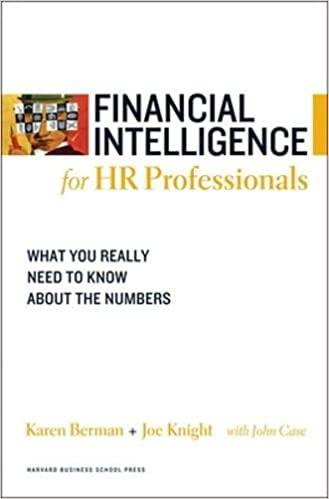Question
Disaster Airlines is a firm in severe financial distress. The firm can no longer pay its bills on time and it is far behind on
Disaster Airlines is a firm in severe financial distress. The firm can no longer pay its bills on time and it is far behind on payments to its banks and long-term debt holders. The firm has decided to either be purchased by another air carrier or liquidate its assets and close. The managers have approached Altruistic Airlines about being acquired. After examining Disasters financial statements, looking at the routes owned by Disaster, and looking at the condition of the fixed assets, Altruistic Airlines has offered to pay the stockholders of Disaster Airlines $8 million to be acquired. Disaster Airlines covers flights to both areas in which Altruistic already flies, but also has routes in areas into which Altruistic is interested in expanding. As part of the analysis, Altruistic determined that the additional cash flows resulting from the acquisition would total $500,000 this year (Year One) and would grow at a rate of 4% for the next three years. After this time, the cash flows would grow at a constant rate of 2% annually for the foreseeable future. The weighted average cost of capital (WACC) of Altruistic Airlines would be 8% after the merger.
If, instead, Disaster Airlines decides to liquidate its assets, it will pay off its debt and give any remaining funds to the firms stockholders. Disaster Airlines balance sheet is attached. The Accrued Wages were earned within the last 90 days prior to filing for bankruptcy. The Unpaid Employee Benefits were due in the six months prior to the filing for bankruptcy. The Unsecured Customer Deposits are for less than $900 each. Disaster Airlines has no property taxes past due. The First Mortgage is secured against the fixed assets of the firm. The Subordinate Debentures are subordinate to the Notes Payable to Banks. The liquidation of the firms Current Assets would produce $186,000; liquidation of the firms fixed assets would produce $800,000. This totals to $986,000 in funds to distribute to the creditors and stockholders of the firm. The trustee expenses associated with the bankruptcy totaled $50,000 and unpaid expenses incurred after the filing of the bankruptcy petition, but before the trustee was appointed totaled $10,000.
Please answer the following questions:
1. What type of merger is the potential merger between Disaster Airlines and Altruistic Airlines
(i.e., horizontal, vertical, congeneric, or conglomerate)?
a. Why or what factors led you to classify the merger this way?
2. Synergy, a situation in which the value of the combined enterprise exceeds the sum
of the values of the firms that are joining, is a typical motivation for a merger to occur.
What synergy(s) do you see between Disaster Airlines and Altruistic Airlines?
3. The Corporate Valuation Model (CVM), described on Slides #17--#49 of the Part Two
Powerpoint file for Chapter 26, can be used to value a potential acquisition candidate.
Given the information provided in the case study above and using the Corporate
Value Model, calculate the maximum value (in millions of dollars) that Altruistic
Airlines should pay for Disaster Airlines stock.
a. In the footnote to the attached balance sheet for Disaster Airlines, it states that Disaster
Airlines currently has 20 million shares of stock outstanding. Given this and the
total value of Disaster Airlines stock that you calculated in Question #3 above, what is
the theoretical offering price for each shareof Disaster Airlines stock that is
outstanding?
b. According to the case study above, Altruistic Airlines has offered $8 million to Disaster
Airlines. Calculate this offering price on a per share basis, based on the 20 million
Stock shares of Disaster Airlines that are outstanding.
c. Why do you think there is a difference between the stock value per share that you
calculated in Question #3.a. and Question #3.b.
4. The other option available to Disaster Airlines is to liquidate under the proceedings of the
bankruptcy court. The proceeds that Disaster Airlines would receive from liquidation of
its assets are described on page one of this case study. Please review the priority of claims
in a Chapter 7 liquidation proceeding, which appear on Slides #30--#33 of the Part Two
Powerpoint file for Chapter 25.
a. What is the total value of creditor(i.e., not stockholder) claims from all sources?
b. What is the total value of the funds available for distribution following the liquidation
of Disaster Airlines assets?
c. Given your answers to Questions #4.a. and #4.b., would you consider Disaster Airlines to
be solvent? Why or why not?
5. Given the information provided in the case study and the priority distribution listing found on
Slides #30--#33 of the Part Two Powerpoint file for Chapter 25, construct a distribution chart showing the dollar valueof each creditor claim that will be satisfied, as well as the percentageof this claim that will be satisfied if Disaster Airlines is liquidated. You may use Slides #36--#37 of the Part Two Powerpoint file for Chapter 25 as a guide when constructing your distribution chart.
6. Given your calculations and analysis in the above questions, would you recommend that
Disaster Airlines liquidate its assets and distribute the proceeds orwould you recommend
that Disaster Airlines accept the $8 million merger offer from Altruistic Airlines orwould you
recommend that Disaster Airlines pursue some other course of action? (Note: Please
identify which of these options you recommend and then explain your reasoning for
your choice.)
Step by Step Solution
There are 3 Steps involved in it
Step: 1

Get Instant Access to Expert-Tailored Solutions
See step-by-step solutions with expert insights and AI powered tools for academic success
Step: 2

Step: 3

Ace Your Homework with AI
Get the answers you need in no time with our AI-driven, step-by-step assistance
Get Started


